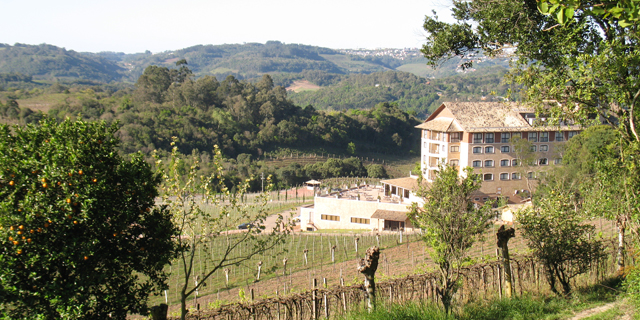Not all of the best South American wine comes from Argentina. Say hello to Brazilian wine, now starting to make it’s mark on the U.S. scene, though the country has a long and wonderful tradition of winemaking. Here’s the 101 on Brazilian wine, what you can expect, and what you should stock up on.
History
Brazil has six distinct climates with more than 211,000 acres under vine. Over 80% of Brazil’s production is within its most developed and southernmost state, Rio Grande do Sul. The area’s colonization began in the late 19th century by immigrants from Germany, Italy, Portugal, and Poland, all of whom made their mark upon its culture. Now, wIth its economy surging, savvy producers are keen to sell their wines abroad, especially in the U.S., where 2 liters of wine are consumed per year, per person.
Bubbles vs. Still
Most of the buzz about Brazilian wine has been of its bubblies, a few which can be found in the United States. Winery development is growing fast in the main sub-region of the warm, maritime climate Serra Gaucha with most of the best only having started operation in this millenium. Brazil’s only demarcated region (D.O.) is its Vale dos Vinhedos (VdV), known for bubblies of Chardonnay and/or Pinot Noir, still red wines of Merlot, Cabernet Franc, and/or Tannat, and for Riesling Italico and/or Chardonnay for whites.
Top Producers
Casa Valduga has been making wine since the first immigrant wave of the late 1800s and the estate was formally organized into a company in 1976 by three brothers Juarez, Erielsoe, and João. As one of the largest bubbly producers in Latin America, they sell 10% of their production directly to the 80,000 visitors who annually roll up at their tasting room and restaurant.
Lidio Carraro, started by Patricia Carraro and her two brothers, has been making wine since 1988, though five generations of Carraros have spent their lives growing grapes for larger wineries. From their hilltop vineyard, the family grows the grapes they need for their excellent wines, especially the Merlot and Nebbiolos.
The Miolo family’s sprawling facility in the heart of the Brazil’s center of quality wine production, Vale dos Vinhedos. The family ramped up in 2000 and now boasts a large distribution company to carry 100 different labels. Its exported bubblies are equal parts Chardonnay and Pinot Noir and exhibit some austerity on the palate unusual for Brazil winemaking. Their red is equal parts Tannat (Uruguay’s flagship grape) and Touriga (Portugal’s top quality grape), and has figgy notes, an olivey nose and big midpalate.
Next up, more of the top producers and a wine hotel…
[pagebreak]
Top Producers
Moët & Chandon has also long had an outpost here. In 1976, the company hired Mario Geisse to oversee its Brazilian sparkling wine production and the Chilean national eventually decided to stablish his own traditional method sparkling wine facility of Vinícola Geisse (now run by his two sons). He helped develop and now employs a Thermal Pest Control machine (sort of a large, mobile hair dryer and shared with other wineries) which allows him to eschew pesticides by encouraging vines to produce bug-repelling antigens and reduce mold pressures. Must try: the 1998 brut bubbly from magnum.
Aurora Winery was established in 1931 by sixteen Italian immigrant families. Now it’s Brasil’s largest winery, a cooperative of 1100 Serra Gaucha family growers within 120 miles of its wine capitol of Bento Gonçalves. All bubbles are made in the bulk-oriented charmat method; worth trying are its Pinot Noir brut and red table wine Carmenère, better known as Chile’s nearly-signature wine grape.
Salton is a firm founded by six hostelier brothers. Now, the modern facility is capable of storing over 17million liters of its wide range of wines which are unsurprisingly of a decidedly commercial bent. Worth trying: Chardonnays, a red wine made from Italy’s Teroldego grape, and a Cabernet Franc which brimmed with fresh fruit character.
The Experience
For a wine-lovers vacation, head to Spa do Vinho, Brazil’s first wine-centric hotel, run by Aldermi and Deborah Dadalt. The hotel houses 660 wine labels, half of which are from Brazil. More like an art than a business, you can try them all (for a fair price) at the hotel’s bar and restaurant. They also house Brazil’s only natural wine brand, Tormentas. The wine is made without oak or sulfur and is a must try before your trip is over.


![Making Mealtime Matter with La Familia: Easy Sofrito [Video]](https://thelatinkitchen.com/wp-content/uploads/2015/10/sofrito-shutterstock__0-500x383.jpg)
![Easy Latin Smoothies: Goji Berry Smoothie [Video]](https://thelatinkitchen.com/wp-content/uploads/2015/12/goji_berry-shutterstock_-500x383.jpg)
















![Fun and Fast Recipes: Fiesta Cabbage Salad [Video]](https://thelatinkitchen.com/wp-content/uploads/2015/11/fiesta_cabbage_slaw-shutterstock_-500x383.jpg)









